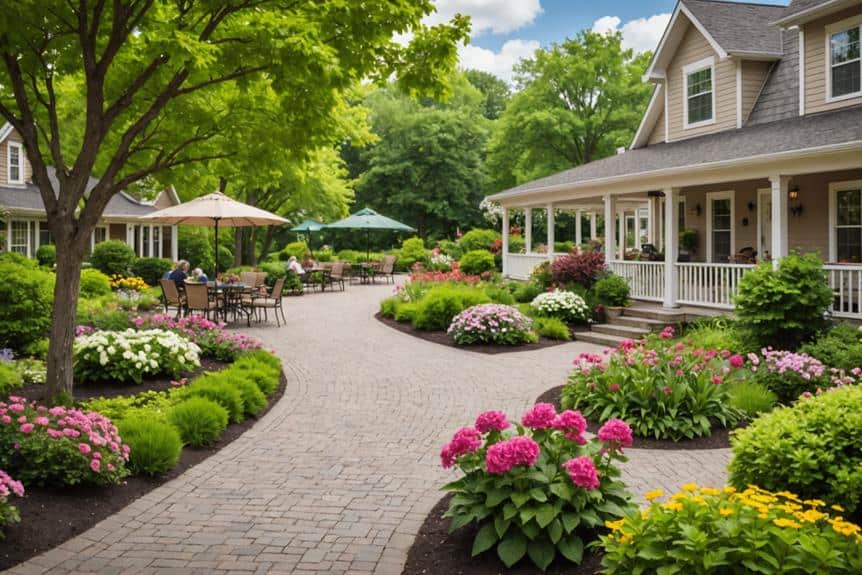When choosing a retirement village, focus on several key factors. First, consider the location; guarantee it's close to healthcare, public transportation, and social connections. Next, evaluate property types, including size, layout, and accessibility features to suit your lifestyle. Look for community activities that foster engagement and allow socialization with neighbors. Financial implications are vital too; assess service charges and potential hidden costs. Finally, examine care options and safety features, like staff availability and emergency protocols. These elements will help you find a place that meets your needs and preferences, guaranteeing comfort and happiness in this new chapter. You'll find essential insights ahead.
Ideal Location Selection
When you're choosing a retirement village, it's important to prioritize the location to assure a fulfilling and comfortable lifestyle. First, consider your access to healthcare facilities. Being close to doctors and hospitals guarantees you can quickly get medical attention if needed, making it critical for your peace of mind. Additionally, look for areas that offer a range of home care services, which can provide support for various needs as you settle into your new surroundings.
Next, think about how easily you can connect with family and friends. A location within walking distance or a short drive helps maintain those important social ties, reducing feelings of loneliness and enhancing your emotional well-being.
Transport accessibility is another key factor. Check the availability of public and community transport services around the village. Easy access to transportation makes it simpler for you to attend social outings, shop for essentials, or participate in recreational activities.
Speaking of activities, look for nearby parks, shops, and cultural attractions. These amenities can greatly contribute to an active and engaging lifestyle, allowing you to explore new interests and meet new people.
Lastly, don't overlook neighborhood safety. A secure environment is essential for your comfort and peace of mind. Knowing that you're in a safe area can elevate your overall retirement experience, allowing you to enjoy your newfound freedom with confidence.
Property Type Considerations
Choosing the right property type in a retirement village can make a significant difference in your day-to-day life. You'll want to contemplate various options like apartments, bungalows, and cottages to find what best suits your lifestyle and mobility needs. Each property type has unique features that can enhance your comfort and enjoyment.
Here are some key factors to think about:
- Apartment size: Do you prefer a cozy space or a larger area for hobbies and guests?
- Bungalow layout: Is a single-story design more accessible and easier for you to navigate?
- Accessibility features: Look for units with wider doorways and emergency help-call units, especially if mobility is a concern.
- Kitchen facilities: Confirm the kitchen is functional and meets your cooking and entertaining needs.
While evaluating these options, reflect on how many bedrooms you need. A spare room can be perfect for guests or serve as a space for your hobbies. Additionally, check the pet policies in the village, as some communities have restrictions that could affect your decision if you have companion animals.
Ultimately, the right property type should reflect your personal preferences and lifestyle while providing the necessary accessibility features. This way, you can enjoy your retirement years comfortably and engage with your community fully.
Community Activities and Engagement
Many villages provide a weekly calendar of events, encouraging you to participate and connect with your neighbors. This can foster a strong sense of community, making it easier to build lasting friendships. Facilities like communal lounges, game rooms, and art studios enhance your opportunities to socialize and pursue hobbies together with fellow residents. Additionally, a supportive community can greatly benefit those who may have experienced the emotional challenges of caregiving. Consider retirement villages that host regular social gatherings, like potlucks or themed parties. These events not only bring people together but also help maintain emotional well-being by keeping you engaged and connected.
Additionally, investigate the availability of volunteer programs or community service opportunities within the village. Engaging in these activities can greatly enhance your social life and provide a sense of purpose, making your retirement years even more fulfilling.
When choosing a retirement village, prioritize those that offer a variety of activities and encourage community engagement. The more opportunities you have to connect with others, the more enjoyable your retirement experience will be. After all, a supportive community can make all the difference in creating a happy and enriching lifestyle.
Financial Implications
When you're exploring financing options, keep in mind that securing a mortgage for a retirement home can be challenging. Many buyers find themselves needing to look into alternative financing solutions to make their move feasible.
Here are some key financial factors to take into account:
- Service charges: These can greatly affect your retirement income and may continue even after you pass away.
- Unexpected fees: Be aware of potential future costs, like maintenance or service charges, that could arise post-purchase.
- Regular expenses: Don't forget about council tax, utilities, and insurance, which are common in retirement villages.
- Long-term budgeting: It's crucial to plan ahead for all these expenses to guarantee a comfortable retirement.
Understanding these financial implications will help you make a more informed decision. By carefully reflecting on these factors, you can enjoy your retirement in a village that meets your community expectations while safeguarding your financial future.
Care Options and Safety Features
Evaluating care options and safety features in retirement villages is essential for guaranteeing your well-being and comfort. When choosing a retirement village, it's imperative to assess the care levels available. These can range from independent living, where you maintain your autonomy, to full-time care, where assistance is readily available. Make certain the level of care aligns with your current and future needs. For example, dementia care should be specialized and tailored to the individual's routines, assuring comfort and familiarity in their living environment, as seen in dementia support services.
Another important factor is the staff-to-resident ratio. A higher ratio often means better personalized attention and support, which can greatly enhance your living experience. Personalized care plans tailored to your individual needs are also essential. These plans guarantee that as your health requirements change over time, you receive the appropriate support and services.
Safety protocols should never be overlooked. Look for retirement villages that provide easy access to emergency medical services. Features such as 24-hour CCTV and on-site security wardens can greatly improve your sense of safety.
Lastly, gathering resident feedback through reviews and ratings is invaluable. This insight can help you understand the quality of care and safety features that the community offers. By taking the time to evaluate these aspects, you can make an informed decision that meets your needs and enhances your peace of mind in your new home.





